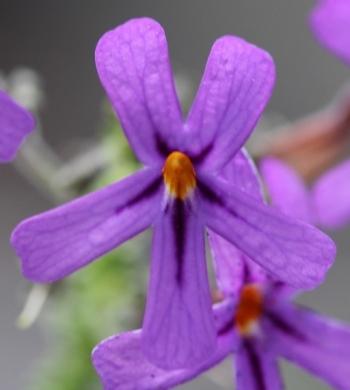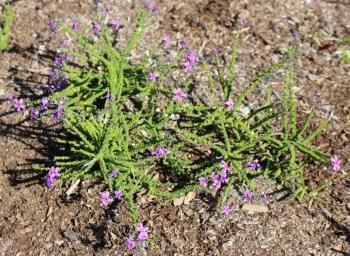Jamesbrittenia microphylla
Jamesbrittenia microphylla (L.f.) Hilliard
Family: Scrophulariaceae
Common names: purple phlox
Introduction
A striking plant with purple, star-like flowers, that are mostly present throughout out the year.

Description
Description
A herbaceous shrublet with a contorted shape, that grows up to about 500 mm tall. The thin stems are covered with very small leathery leaves, which are closely spaced to one another.

Flowers are star-like, purple to mauve, with dark purple streaks and a yellow throat. Each flower appears on its own at the tip of a pedicel, and each will normally produce more than one flower.

Flowering occurs sporadically throughout the year (January to December). Jamesbrittenia microphylla is relatively fast growing and not long lived.
Conservation Status
Status
Jamesbrittenia microphylla is not threatened, and is assessed as Least Concern (LC) on the Red List of South African plants.
Distribution and habitat
Distribution description
Purple phlox occurs in the undergrowth of coastal scrub and in grasslands, from Knysna in the Western Cape, to Port Alfred in the Eastern Cape.

Derivation of name and historical aspects
History
The genus Jamesbrittenia is named after the British botanist and biographer James Britten (1846–1924), who was a plant collector in the late 1800s. The species name microphylla is Latin and describes the small leaves, micro meaning ‘small’ and phylla, ‘leaf’.

Ecology
Ecology
The small leathery leaves are well adapted to the sometimes harsh and desiccating coastal conditions.
Uses
Use
The leaves and roots of J. microphylla are used in traditional medicine for alleviating skin related disorders.

Growing Jamesbrittenia microphylla
Grow
Purple phlox is easily propagated from stem cuttings taken in the spring and summer months. This plant roots easily in river sand or well-drained media that allows good aeration. Cuttings can be treated with rooting hormone to hasten the rooting.
Jamesbrittenia microphylla makes a good pot plant and complements other herbaceous perennials in a hanging basket display. It doesn’t mind poor soils and also grows well in a rockery.
References
- Manning, J. 2001. Eastern Cape. South African Wild Flower Guide 11. Botanical Society of South Africa, Cape Town.
- Pooley, E. 1998. A field guide to wild flowers Kwazulu-Natal and the eastern region. Natal Flora Publications Trust, Durban.
- Raimondo, D. et al. 2009. Red list of South African plants. Strelitzia 25. SANBI (South African National Biodiversity Institute), Pretoria.
Credits
Phakamani M’Afrika Xaba
Kirstenbosch National Botanical Garden
January 2018
Plant Attributes:
Plant Type: Shrub
SA Distribution: Eastern Cape, Western Cape
Soil type: Sandy, Loam
Flowering season: Sporadic/All year
PH: Acid, Neutral
Flower colour: Purple
Aspect: Full Sun
Gardening skill: Average
Special Features:
Horticultural zones








Rate this article
Article well written and informative
Rate this plant
Is this an interesting plant?
Login to add your Comment
Back to topNot registered yet? Click here to register.